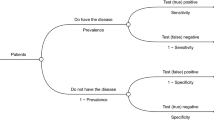Abstract
Diagnostic tests allow better informed medical decisions when there is uncertainty about a patient’s health status and, therefore, about the desirability to undertake treatment. This paper studies the relation between the expected value of diagnostic information and a patient's risk aversion. We show that the ex ante value of diagnostic information increases with risk aversion for diseases with low prevalence, but decreases with risk aversion for diseases with high prevalence. On the other hand, the ex post value of diagnostic information always increases with the patient's degree of risk aversion.



Similar content being viewed by others
Notes
Allowing for imperfect tests would complicate the analysis and requires using different concepts of risk aversion. We leave this for future research.
Theorem 1 in Jewitt (1987, p. 75) is as follows: Let the distribution functions \(F\) and \(G\) cross exactly once, and suppose that \(G\) crosses \(F\) from below. It follows that \(\int u\mathrm{d}G\ge \int u\mathrm{d}F\) implies \(\int v\mathrm{d}G\ge \int v\mathrm{d}F\) whenever \(u\) and \(v\) are both increasing with \(v\) more risk averse than \(u\) in the sense of Arrow–Pratt.
References
Bleichrodt, H., & Pinto, J. L. (2005). The validity of QALYs under non-expected utility. The Economic Journal, 115(503), 533–550.
Ebert, S., Nocetti, D., & Schlesinger, H. (2018). Greater mutual aggravation. Management Science, 64(6), 2809–2811.
Eeckhoudt, L. (2002). Risk and medical decision making. Boston: Kluwer Academic Publishers.
Eeckhoudt, L., Lebrun, T., & Sailly, J. C. (1984). The informative content of diagnostic tests: an economic analysis. Social Science and Medicine, 18(10), 873–880.
Eeckhoudt, L., Lebrun, T., & Sailly, J. C. (1985). Risk-aversion and physicians medical decision-making. Journal of Health Economics, 4(3), 273–281.
Eeckhoudt, L., Rey, B., & Schlesinger, H. (2007). A good sign for multivariate risk taking. Management Science, 53(1), 117–124.
Felder, S., & Mayrhofer, T. (2014). Risk preferences: consequences for test and treatment thresholds and optimal cutoffs. Medical Decision Making, 34(1), 34–41.
Freixas, X., & Kihlstrom, R. (1984). Risk aversion and information demand. In M. Boyer & R. Kihlstrom (Eds.), Bayesian Models of Economic Theory (pp. 93–104). Amsterdam: Elsevier.
Gollier, C., & Pratt, J. W. (1996). Risk vulnerability and the tempering effect of background risk. Econometrica, 64(5), 1109–1123.
Gould, J. (1974). Risk, stochastic preference, and the value of information. Journal of Economic Theory, 8, 64–84.
Hilton, R. (1981). The determinants of information value: synthesizing some general results. Management Science, 27(1), 57–64.
Jewitt, I. (1987). Risk aversion and the choice between risky prospects: the preservation of comparative statics results. Review of Economic Studies, 54, 73–85.
Kőszegi, B. (2003). Health anxiety and patient behavior. Journal of Health Economics, 22(6), 1073–1084.
Maccheroni, F., Marinacci, M., & Ruffino, D. (2013). Alpha as ambiguity: robust mean-variance portfolio analysis. Econometrica, 81(3), 1075–1113.
McNeil, B. J., Weichselbaum, R., & Pauker, S. G. (1981). Tradeoffs between quality and quantity of life in laryngeal cancer. New England Journal of Medicine, 305, 982–987.
Pauker, S., & Kassirer, J. (1980). The threshold approach to clinical decision making. New England Journal of Medicine, 302, 1109–1117.
Pratt, J. W. (1964). Risk aversion in the small and in the large. Econometrica, 32, 122–136.
Sandmo, A. (1971). On the theory of the competitive firm under price uncertainty. The American Economic Review, 61(1), 65–73.
Stiggelbout, A. M., Kiebert, G. M., Kievit, J., Leer, J. W. H., Stoter, G., & De Haes, J. C. J. M. (1994). Utility assessment in cancer patients adjustment of time tradeoff scores for the utility of life years and comparison with standard gamble scores. Medical Decision Making, 14(1), 82–90.
Willinger, M. (1989). Risk aversion and the value of information. The Journal of Risk and Insurance, 56(1), 104–112.
Author information
Authors and Affiliations
Corresponding author
Additional information
Publisher's Note
Springer Nature remains neutral with regard to jurisdictional claims in published maps and institutional affiliations.
Rights and permissions
About this article
Cite this article
Bleichrodt, H., Crainich, D., Eeckhoudt, L. et al. Risk aversion and the value of diagnostic tests. Theory Decis 89, 137–149 (2020). https://doi.org/10.1007/s11238-020-09750-8
Published:
Issue Date:
DOI: https://doi.org/10.1007/s11238-020-09750-8




